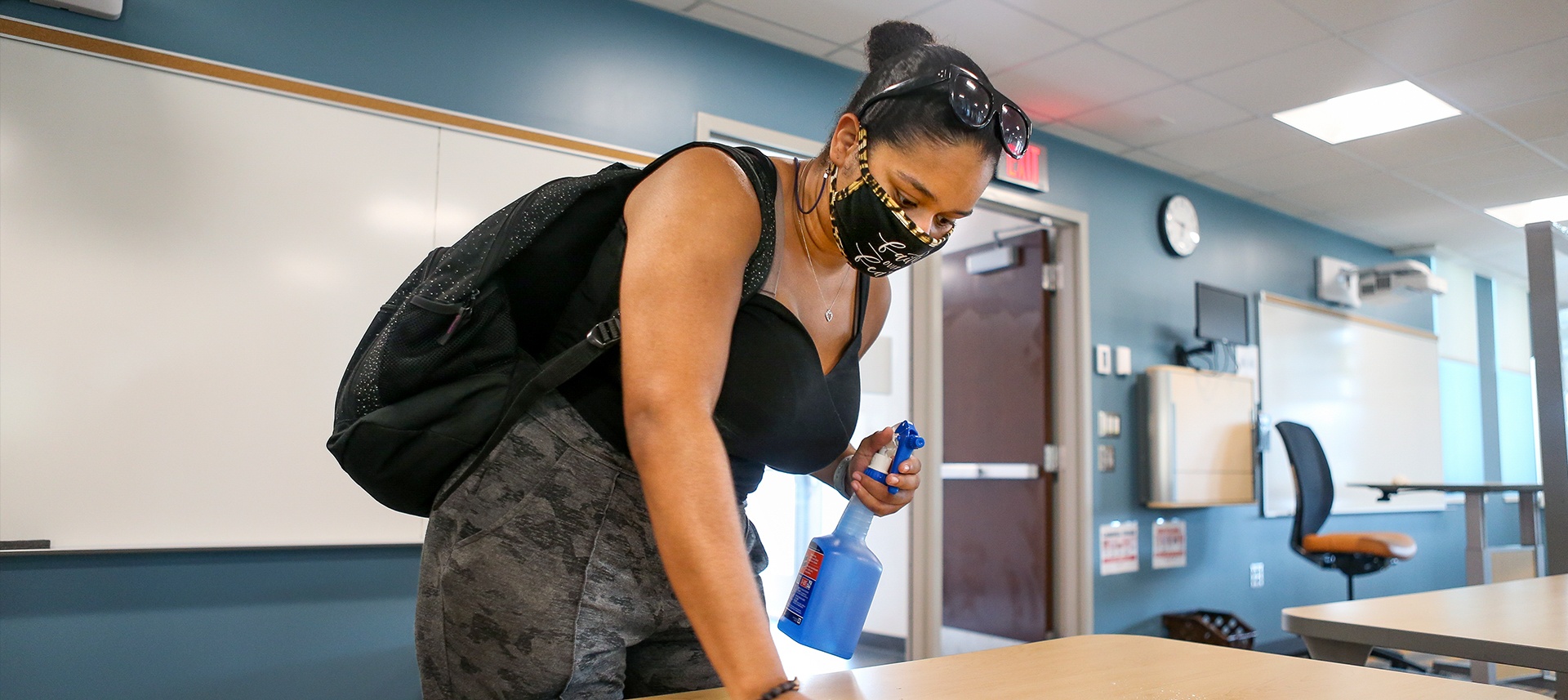

Forward Falcons Q&A Series: Campus Cleaning and Safety Protocols
As Bowling Green State University prepares for the fall semester, it is implementing new and enhanced cleaning technology and protocols on its campuses with direction from the Centers for Disease Control (CDC), the State of Ohio and Ohio Department of Health, the Wood County Health Department and the Erie County Health Department.
Sherideen Stoll, chief financial officer and vice president of finance and administration, is answering some of the most frequently asked questions about cleaning protocols on campus.
Q. What will classrooms, common spaces and offices look like?
A. As we’ve prepared classroom and office spaces for the repopulation of our campuses, we are building in layers of protection, including face coverings, face shields and physical distance. We have installed plexiglass shields between faculty instruction spaces and the classroom, information or checkout stands and at reception desks. We have also implemented queuing lines that include physical distancing. All classrooms have been spaced to allow for six feet of physical distancing between students.
Students, employees and visitors will be required to wear a face covering in all indoor public and shared environments. In the absence of the ability to maintain physical distance, face coverings will be required in outdoor spaces as well. All faculty, students and employees will be provided one reusable face covering. Disposable face coverings will be available on carts in the classrooms and also on the hand sanitizer stands in main hallways throughout campus. Additional information about face covering guidelines can be found on our Forward Falcons website.
For faculty and staff, as offices are repopulated, department chairs or directors have assessed common spaces using an assessment checklist to ensure adequate physical distancing can be achieved. If it cannot, we have labeled furnishings, installed temporary barriers or reconfigured spaces so that we can achieve distancing.
Q. What will cleaning protocols look like?
A. We are using a new line of cleaning supplies, including a disinfectant with a 45-second kill-time for the virus, along with technologies such as electrostatic cleaning and autonomous vacuums to make our campus as clean as possible. In addition to the University’s standard cleaning practices, a team of highly trained Campus Operations personnel will be deployed to rotate through buildings to perform enhanced cleaning. This includes frequent cleaning of high touch points such as door knobs, push bars, railings and elevator buttons. Areas will be thoroughly cleaned, first using disinfectant, with electrostatic spraying units to clean commonly used spaces daily. There will also be additional hand sanitizer stations throughout our campuses, located at building entrances and elevator lobbies.
Each classroom will have a sanitization cart stocked with PPE and sanitizing wipes and supplies for individuals who want to wipe down personal spaces. We have introduced partnered cleaning and will request that everyone do their part to assist with disinfecting spaces. Cleaning products will be provided in labs, dining halls, residence halls and meeting rooms so students, faculty and staff can do their part to prevent surface transmission of pathogens. When utilizing these spaces, please use the supplies to disinfect before and after each use.
In addition to classrooms, Campus Operations staff will provide regular cleaning and sanitizing of common areas, including offices. In addition, each person must actively wipe down their personal spaces. We’ve also begun using electrostatic sprayers in offices and we will be using them in classrooms and other common spaces.
Q. How will the University create the safest environment possible for everyone?
A. We have evaluated our classrooms and prepared them with the necessary distancing layout and plexiglass barriers. Residence halls will also have new guidelines, including single-entrance and exit points, hand-sanitizing stations in high traffic areas inside of the buildings, limited student gatherings and a no-guest policy.
We have adjusted our HVAC and other building air systems to increase the total outside air concentrations delivered to the supply system and reduced or eliminated any inside air recirculation. Additionally, we have upgraded the air filtration in our HVAC systems to higher ratings where feasible based on CDC recommendations, subject to compatibility with each individual systems design, to achieve the highest level of filtration possible for each respective unit. We have also adjusted air exhaust fans in restrooms and other areas to ensure they are functioning at maximum capacity whenever buildings are occupied.
Updated: 09/03/2020 04:13PM




